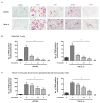Fucoxanthin Suppresses Osteoclastogenesis via Modulation of MAP Kinase and Nrf2 Signaling
- PMID: 33673704
- PMCID: PMC7997314
- DOI: 10.3390/md19030132
Fucoxanthin Suppresses Osteoclastogenesis via Modulation of MAP Kinase and Nrf2 Signaling
Abstract
Fucoxanthin (FX), a natural carotenoid present in edible brown seaweed, is known for its therapeutic potential in various diseases, including bone disease. However, its underlying regulatory mechanisms in osteoclastogenesis remain unclear. In this study, we investigated the effect of FX on osteoclast differentiation and its regulatory signaling pathway. In vitro studies were performed using osteoclast-like RAW264.7 cells stimulated with the soluble receptor activator of nuclear factor-κB ligand or tumor necrosis factor-alpha/interleukin-6. FX treatment significantly inhibited osteoclast differentiation and bone resorption ability, and downregulated the expression of osteoclast-specific markers such as nuclear factor of activated T cells 1, dendritic cell-specific seven transmembrane protein, and matrix metallopeptidase 9. Intracellular signaling pathway analysis revealed that FX specifically decreased the activation of the extracellular signal-regulated kinase and p38 kinase, and increased the nuclear translocation of phosphonuclear factor erythroid 2-related factor 2 (Nrf2). Our results suggest that FX regulates the expression of mitogen-activated protein kinases and Nrf2. Therefore, FX is a potential therapeutic agent for osteoclast-related skeletal disorders including osteoporosis and rheumatoid arthritis.
Keywords: MAP kinase; Nrf2; brown seaweed; fucoxanthin; osteoclastogenesis.
Conflict of interest statement
The authors declare no conflict of interest.
Figures








Similar articles
-
Dehydrocostus lactone inhibits NFATc1 via regulation of IKK, JNK, and Nrf2, thereby attenuating osteoclastogenesis.BMB Rep. 2020 Apr;53(4):218-222. doi: 10.5483/BMBRep.2020.53.4.220. BMB Rep. 2020. PMID: 31964469 Free PMC article.
-
Shikimic Acid Inhibits Osteoclastogenesis in Vivo and in Vitro by Blocking RANK/TRAF6 Association and Suppressing NF-κB and MAPK Signaling Pathways.Cell Physiol Biochem. 2018;51(6):2858-2871. doi: 10.1159/000496039. Epub 2018 Dec 14. Cell Physiol Biochem. 2018. PMID: 30562759
-
Ecklonia cava Extract Containing Dieckol Suppresses RANKL-Induced Osteoclastogenesis via MAP Kinase/NF-κB Pathway Inhibition and Heme Oxygenase-1 Induction.J Microbiol Biotechnol. 2019 Jan 28;29(1):11-20. doi: 10.4014/jmb.1810.10005. J Microbiol Biotechnol. 2019. PMID: 30518021
-
Curculigoside attenuates oxidative stress and osteoclastogenesis via modulating Nrf2/NF-κB signaling pathway in RAW264.7 cells.J Ethnopharmacol. 2021 Jul 15;275:114129. doi: 10.1016/j.jep.2021.114129. Epub 2021 Apr 18. J Ethnopharmacol. 2021. PMID: 33878416
-
Molecular Nutritional Research for Effective Utilization of Marine Lipid-soluble Components.J Oleo Sci. 2025;74(4):329-340. doi: 10.5650/jos.ess25013. J Oleo Sci. 2025. PMID: 40175114 Review.
Cited by
-
Fucoxanthin from Algae to Human, an Extraordinary Bioresource: Insights and Advances in up and Downstream Processes.Mar Drugs. 2022 Mar 23;20(4):222. doi: 10.3390/md20040222. Mar Drugs. 2022. PMID: 35447895 Free PMC article. Review.
-
A Systematic Review on Marine Algae-Derived Fucoxanthin: An Update of Pharmacological Insights.Mar Drugs. 2022 Apr 22;20(5):279. doi: 10.3390/md20050279. Mar Drugs. 2022. PMID: 35621930 Free PMC article.
-
In Vitro Insights into the Role of 7,8-Epoxy-11-Sinulariolide Acetate Isolated from Soft Coral Sinularia siaesensis in the Potential Attenuation of Inflammation and Osteoclastogenesis.Mar Drugs. 2024 Feb 19;22(2):95. doi: 10.3390/md22020095. Mar Drugs. 2024. PMID: 38393066 Free PMC article.
-
Mechanism of regulating macrophages/osteoclasts in attenuating wear particle-induced aseptic osteolysis.Front Immunol. 2023 Oct 4;14:1274679. doi: 10.3389/fimmu.2023.1274679. eCollection 2023. Front Immunol. 2023. PMID: 37860014 Free PMC article. Review.
-
Effects of Supplementation with Microalgae Extract from Phaeodactylum tricornutum (Mi136) to Support Benefits from a Weight Management Intervention in Overweight Women.Nutrients. 2024 Mar 28;16(7):990. doi: 10.3390/nu16070990. Nutrients. 2024. PMID: 38613023 Free PMC article. Clinical Trial.
References
MeSH terms
Substances
Grants and funding
LinkOut - more resources
Full Text Sources
Other Literature Sources

